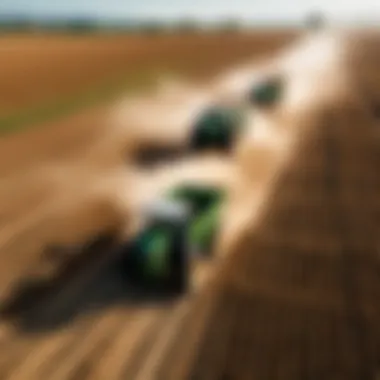Harvest Time Management Systems: An In-Depth Look


Intro
In the ever-evolving realm of agriculture, the significance of systems designed for harvest time management cannot be overstated. These systems are vital, serving both as a backbone for operational efficiency and a catalyst for enhanced productivity. With increasing global demand for food, integrating effective time management practices becomes not just beneficial, but essential for stakeholders across the agricultural sector.
As we explore the intricacies of harvest time management systems, this article aims to provide a comprehensive overview of the key components and technologies involved. We will highlight strategies that improve decision-making processes for B2B software users. The discussion will encompass how these systems assist in ensuring timely harvests, proper resource allocation, and optimized productivity.
Through this exploration, decision-makers and involved stakeholders will gain a clear understanding of the relevance of these systems in today's agricultural landscape, especially in light of recent technological advancements that streamline farming practices.
Key Features
Harvest time management systems are structured around several core features that streamline operations and enhance productivity.
Overview of Features
- Real-time Monitoring: These systems enable users to track the growth stages of crops and predict optimal harvest times based on various conditions, including weather and soil health.
- Resource Allocation: Effective systems streamline the allocation of labor and equipment, minimizing idle time and ensuring that all resources are utilized efficiently.
- Data Analytics: The integration of analytical tools provides insights into crop yields and performance, which helps in making informed decisions for future planting and harvesting cycles.
- Collaboration Tools: Facilitate communication among different stakeholders, including farmers, supply chain managers, and technologies involved in the harvesting process.
Unique Selling Points
The unique selling points of these harvest time management systems heavily contribute to their growing adoption in agriculture:
- Customization: Many systems offer customizable features to adapt to specific farming practices and environments.
- Integration: They easily integrate with existing agricultural technologies, enhancing their effectiveness and user acceptance.
- Scalability: Suitable for both small farms and larger agricultural enterprises, making them versatile for different operations.
"Effective harvest time management systems are pivotal in transitioning agricultural practices into a more data-driven future."
Pricing Structure
Understanding the pricing structure of harvest time management systems is critical for organizations planning to invest in these tools.
Tiered Pricing Plans
Pricing may vary significantly depending on the features and scalability options offered. Potential plans may include:
- Basic Plan: Foundational features suitable for small farms.
- Standard Plan: Includes advanced analytics and collaboration tools for medium-sized operations.
- Premium Plan: Comprehensive support, data integration, and customization options for large enterprises.
Features by Plan
Each pricing tier often provides distinct features. An overview might include:
- Basic Plan:
- Standard Plan:
- Premium Plan:
- Real-time Monitoring
- Basic Data Analytics
- All Basic features plus Resource Allocation
- Enhanced Data Analytics
- All Standard features plus Customization Options
- Complete Integration Support
This streamlined pricing approach allows stakeholders to choose the best option fitting their specific requirements and budget constraints, ensuring accessibility in the agricultural sector.
Prolusion to Harvest Time Management Systems
In contemporary agriculture, the integration of technology into operational processes has become vital. The Harvest Time Management System emerges as a crucial tool for enhancing productivity and efficiency during the harvest phase. The purpose of this article is to provide an in-depth exploration of these systems, shedding light on their components, benefits, and the considerations that agricultural stakeholders must keep in mind.
Definition and Purpose
A Harvest Time Management System serves as a digital solution designed to optimize the timing and effectiveness of agricultural harvests. This system typically encompasses software tools aimed at managing various aspects of the harvest process, including scheduling tasks, tracking resources, and analyzing performance data. The primary purpose is to streamline operations, ensuring that all agricultural activities occur in a timely manner, reducing waste, and maximizing yield.
The definition of such a system can vary depending on the jurisdiction and the specific needs of the operation. However, the overarching aim remains consistent—facilitating improved time management and resource allocation in the harvest phase. By centralizing critical data points, farmers and farm managers can make better-informed decisions, ultimately leading to enhanced productivity.
Importance in Agricultural Operations
The significance of implementing efficient harvest time management systems cannot be overstated. In an industry where timing can dictate success or failure, such systems provide a clear framework to enhance operational effectiveness.
- Enhanced Decision-Making: With real-time data tracking, managers gain faster insights into their operations. This allows them to respond promptly to changing conditions, such as weather impacts or resource availability.
- Resource Optimization: These systems facilitate the optimal allocation of both human and material resources, ensuring that all aspects of the harvest process are aligned with overall business objectives.
- Increased Productivity: By minimizing downtime through effective scheduling and task management, agricultural operations can harvest crops at their peak, directly impacting yield and quality.
- Cost Efficiency: Automating processes reduces the risk of human error, leading to lowered operational costs over time. This financial benefit is critical for maintaining competitiveness in the market.
- Sustainability Practices: Many systems include features aimed at promoting sustainable farming practices, which not only benefit the environment but also cater to the growing consumer demand for responsibly-sourced products.


In summary, Harvest Time Management Systems play a fundamental role in modern agricultural practices, addressing the challenges of timing, efficiency, and resource management with precision. As these systems continue to evolve, their importance in agriculture will only increase, driving better outcomes for farmers and the industry at large.
Key Components of Time Management Systems
The efficiency of a harvest time management system heavily relies on its core components. Understanding these elements is essential for optimizing agricultural processes. Each component plays a unique role in enhancing productivity, ensuring that operations run smoothly during critical phases of the harvest. Here is a look at the crucial features that impact agricultural effectiveness:
Task Scheduling Features
Task scheduling is the backbone of any harvest time management system. It allows farmers and managers to assign specific tasks to teams based on priority and timelines. By utilizing scheduling tools, managers can create a clear roadmap for daily operations, which improves accountability among workers. The features often include:
- Time Slots: Allocating dedicated time blocks for specific tasks, ensuring optimal use of resources.
- Reminders: Notifications for impending deadlines or task completions, aiding teams to stay on track.
- Flexibility: Adapting schedules in real-time in response to weather changes or unforeseen circumstances.
These features contribute to minimizing downtime and maximizing output, which is vital during the busy harvest season.
Resource Allocation Tools
Effective resource allocation is essential in managing inputs like labor, machinery, and supplies. By utilizing specialized tools, agricultural businesses can streamline their resources for tasks that demand them most. These tools often provide:
- Inventory Monitoring: Keeping tabs on stock levels ensures that materials are available when needed.
- Cost Management: Allocating resources efficiently can help reduce overhead costs and maximize profit margins.
- Labor Management: Tracking labor allocation across various tasks ensures that human resources are utilized effectively.
Optimizing resource allocation not only enhances productivity but also leads to better cost-effectiveness in operations.
Data Tracking and Reporting
Data tracking is a pivotal component of time management systems. Accurate data collection allows agricultural enterprises to monitor performance, detect inefficiencies, and make informed decisions. Systems often include:
- Performance Metrics: Evaluating key performance indicators (KPIs) for tasks and overall operations.
- Historical Data Analysis: Looking back at past harvests can provide insights into what practices worked effectively.
- Reporting Tools: Generating reports that visualize data trends, helping stakeholders to understand patterns over time.
By leveraging data effectively, agricultural businesses can refine their time management strategies to foster continual improvements and informed decision-making.
By focusing on these key components, stakeholders can create a more organized and efficient approach to harvest management.
Technological Advances in Harvest Management
Technological advancements in the field of harvest management are reshaping agricultural practices. These innovations not only enhance productivity but also streamline processes for better efficiency. As farms become more complex, the integration of technology becomes essential. This section examines specific elements like mobile applications, IoT devices, and artificial intelligence, focusing on their benefits and considerations in modern harvest management systems.
Mobile Applications for On-the-Go Efficiency
Mobile applications have gained popularity in harvest management for their ability to facilitate real-time decision-making. Farmers and managers can access vital information at any time, leading to quicker responses to changing conditions.
- Task Management: These apps allow for easy planning and tracking of tasks. Users can assign jobs and update progress from the field.
- Data Access: Real-time data access enables immediate assessments of conditions like weather or crop health. This, in turn, enhances productivity and reduces delays.
- Collaboration: Team members can communicate and share updates instantly, fostering collaboration and agility in management.
These mobile platforms empower users, allowing them to manage their resources more effectively than traditional methods.
Integration with IoT Devices
The integration of IoT devices in harvest management systems represents a significant shift towards smart farming. IoT technology connects various tools and equipment to the internet, creating an interconnected ecosystem on farms. This connectivity allows for:
- Remote Monitoring: Users can monitor crop conditions or machinery performance from afar. Sensors collect data and send it in real-time, allowing for proactive management.
- Precision Agriculture: By using IoT devices, farmers can implement precision agriculture practices. This means using resources more judiciously, whether it is water, fertilizers, or pesticides.
- Automated Systems: Many IoT devices come with automation features. This can reduce the need for manual labor and lower operational costs.
IoT integration facilitates a data-driven approach, where decisions are based on real-time insights rather than assumptions.
Artificial Intelligence and Machine Learning
Artificial Intelligence (AI) and machine learning are at the forefront of the future of agricultural technology. These technologies provide powerful tools to analyze vast amounts of data, enabling:
- Predictive Analytics: AI systems can analyze historical and real-time data to forecast potential issues. This might include predicting diseases or forecasting harvest timings, which leads to better planning.
- Resource Optimization: Machine learning algorithms help optimize resource usage. This could be in terms of water, nutrients, or even labor. Better optimization ultimately leads to higher yields.
- Customization of Strategies: Different farms have unique challenges. AI can analyze specific conditions on a farm and suggest tailored strategies for management.
Incorporating AI and machine learning in harvest management enhances decision-making processes, fostering efficiency and productivity in agriculture.
In summary, the integration of mobile applications, IoT devices, and AI technologies in harvest management signifies a transformative phase in agriculture. With these tools, farms can become more efficient, sustainable, and responsive to real-time challenges.
Challenges in Implementing Time Management Systems


Implementing a harvest time management system can present various challenges. Understanding these challenges is crucial because they can impact the effectiveness and the overall success of the system. Addressing these obstacles early can facilitate a smoother transition and enhance productivity.
Resistance to Change in Traditional Practices
Many agricultural operations rely on traditional methods, which have been in place for years or even decades. This resistance to change can create hurdles when introducing new time management systems. Workers and decision-makers may feel comfortable with established practices, believing that changing to a new system is unnecessary or overly complex. \n\nFurthermore, adapting to new technology requires effort. Training staff to use new tools, schedules, and reports takes time and can disrupt established workflows. To combat this resistance, it is vital to communicate the benefits of time management systems clearly. For instance, increased efficiency and better data-driven decision-making can be highlighted.
Data Security Concerns
Data security is another critical challenge during the implementation of these systems. Harvest time management systems often collect sensitive operational data, including production schedules, resource allocations, and financial information. If not properly protected, this data can become vulnerable to breaches. \n\nOrganizations must proactively address these data security concerns. They should invest in strong cybersecurity measures, such as encryption, access controls, and regular security audits. It is also essential to ensure compliance with data protection regulations, as non-compliance can lead to hefty fines and reputational damage.
Cost Implications of Transitioning to New Systems
Transitioning to a new harvest time management system comes with significant cost implications. Initial investments can include software purchases, hardware updates, and staff training programs. Smaller farms, in particular, may struggle with these costs, impacting their willingness to adopt new technologies. \n\nYet, understanding the long-term cost benefits is vital. An effective time management system can lead to improved productivity, reduced waste, and increased profit margins over time. Proper cost-benefit analysis can help justify the initial investments and reassure stakeholders about the potential returns.
Investment in the right tools today can prevent costly mistakes tomorrow.
In summary, while the challenges of implementing harvest time management systems can be significant, they are not insurmountable. Understanding resistance to change, addressing data security, and analyzing cost implications constructively can aid organizations in adopting these systems effectively.
Best Practices for Utilizing Harvest Time Management Systems
Using harvest time management systems effectively is essential for optimizing agricultural productivity. Companies that harness the power of these systems can significantly improve their decision-making and efficiency. Below are some key best practices that highlight the elements needed for successful utilization of these systems. Each practice can lead to better outcomes within agricultural operations, helping to create a more streamlined workflow and maximizing resources.
Training and Development for Staff
Training staff on the optimal use of harvest time management systems is crucial. Familiarity with the software enhances workers’ confidence and efficiency. A well-structured training program can cover various aspects, such as:
- Understanding the user interface
- Familiarization with key features like scheduling and resource management
- Continuous learning modules to adapt to system updates
Organizations should consider regular workshops that encourage hands-on practice. This approach can address various skill levels within the workforce, ensuring everyone is competent. Also, having designated super-users or champions proficient with the system can provide ongoing support, clarifying doubts and guiding peers.
Regular System Audits and Updates
Conducting regular audits of the harvest time management systems provides insights into performance and functionality. Companies should establish a routine to evaluate how effectively the system meets the operational needs. Important considerations include:
- Identifying performance bottlenecks
- Ensuring data accuracy and integrity
- Updating software to leverage new features
Staying abreast of new technologies is key. Software vendors often release updates that contain enhancements or fix bugs. Prompt updates can lead to improved performance and user satisfaction, translating into better productivity during the harvest.
Leveraging Data Insights for Decision Making
Using the data generated by harvest time management systems effectively can lead to significant performance improvements. Data insights allow agricultural businesses to:
- Identify trends over seasons
- Allocate resources more efficiently
- Make informed decisions based on predictive analytics
Moreover, being able to access real-time data can streamline operations. For instance, understanding the productivity levels of different teams can help in resource allocation. Implementing dashboards that visualize data in an accessible manner enables quicker decision-making for stakeholders.
"Effective use of data insights transforms operational strategies, leading to enhanced productivity."
In summary, applying these best practices can greatly enrich the performance of harvest time management systems, ultimately benefiting agricultural enterprises. Staff training, systematic audits, and data-driven decisions create a robust foundation for continuous improvement.
Case Studies of Successful Implementation
Examining case studies of harvest time management systems is crucial. These examples provide tangible insights into practical applications. They demonstrate how different agricultural enterprises utilize these systems, leading to increased efficiency and productivity. By analyzing these instances, stakeholders can better understand what works and what doesn’t in various contexts. This reinforces the value of adopting such systems for organizations at any scale.
Example from Large-Scale Farms
Large-scale farms often face numerous challenges, from managing vast resources to coordinating labor across extensive fields. One notable example is Cargill, which implemented a comprehensive harvest time management system. This system streamlined communication among teams, helping them track progress in real-time.
Key advantages observed include:
- Improved labor deployment through efficient scheduling.
- Enhanced yield monitoring, which reduced waste.
- Better resource allocation, decreasing operational costs.
The reaction from management was overwhelmingly positive. They noted significant increases in overall productivity and a smoother workflow during peak harvest seasons. This case underlines how a sophisticated time management system can transform large agricultural operations.


Innovative Solutions in Medium-Sized Enterprises
Medium-sized enterprises also benefit from tailored harvest time management solutions. For instance, Blue Diamond Growers has utilized a custom system that integrates data analytics to improve how they manage harvest timings. This enables them to make informed decisions based on real-time data.
Some notable impacts include:
- Increased efficiency in resource management.
- Better forecasting capabilities leading to timely interventions.
- Heightened visibility across all operations, leading to better collaboration among teams.
This case exemplifies how medium-sized farms can implement creative solutions, adapting technologies in alignment with their specific needs. By actively using harvest time management systems, they have not only enhanced productivity but also fostered a culture of continuous improvement.
Small Farms Leveraging Technology
Even small farms are discovering the value of time management systems. A prime example is Cedar Grove Farms, which adopted a user-friendly mobile application to handle their harvest schedules. This application allows farmers to set reminders and manage tasks directly from their smartphones.
Benefits noted by Cedar Grove Farms include:
- Simplified task management leading to fewer delays.
- Increased adaptability to changing weather conditions.
- Enhanced communication among team members, regardless of location.
The implementation was straightforward and resulted in immediate benefits, proving that even small operations can leverage technology effectively. This demonstrates a growing trend where small farms are not left behind in the digital agricultural revolution, instead finding innovative ways to boost their operational efficiency.
Future Trends in Harvest Time Management
The management of harvest time is evolving with increasing technological integration and changing market demands. Future trends in harvest time management are critical because they shape how agricultural operations can enhance efficiency and productivity. By focusing on these trends, businesses can adapt to emerging challenges and optimize their resource use. Understanding these trends is essential for decision-makers in agriculture, ensuring that they stay competitive in a fast-evolving industry.
Sustainability and Environmental Considerations
Sustainability is becoming a key focus in harvest time management. As climate change and environmental concerns escalate, agricultural businesses must incorporate practices that minimize negative impacts. This involves several elements:
- Resource Efficiency: Using advanced analytics, farms can optimize water usage, reduce chemical runoff, and minimize energy consumption.
- Sustainable Practices: Techniques like crop rotation, cover cropping, and reduced tillage gain popularity as they improve soil health and biodiversity.
- Compliance with Regulations: New environmental policies require farmers to adopt sustainable methods. A time management system that integrates sustainability considerations can help ensure compliance and avoid penalties.
The push for sustainability in harvest time management is not only beneficial for the environment but also enhances brand value among consumers who prioritize eco-friendly practices.
Enhanced Predictive Analytics Capabilities
Integrating predictive analytics into harvest time management systems offers several advantages. This technology allows for:
- Improved Forecasting: Predictive models can analyze historical data and current trends to forecast crop yields much accurate.
- Risk Mitigation: By anticipating potential disruptions from weather patterns or market changes, farmers can take proactive measures.
- Data-Driven Decisions: Access to predictive insights allows stakeholders to make informed decisions quickly. "Data-driven agriculture" is becoming a common phrase as data semantics evolve within the sector.
As technology advances, predictive analytics will continue to play a pivotal role in ensuring that agricultural businesses can accommodate future fluctuations in demand and supply.
Collaborative Platforms and Shared Resources
Collaboration among various stakeholders in the agricultural supply chain is an emerging trend that enhances efficiency. Future harvest time management systems are likely to focus on:
- Platform Integration: A focus on interconnected systems allows information sharing between farmers, suppliers, and distributors. This increases transparency and operational harmony.
- Shared Resources: Collaborative platforms enable resource sharing, which is crucial for cost-efficiency, especially among small to mid-sized farms. By sharing equipment, data, or even labor, these entities can optimize their operations.
- Community Engagement: Farms leveraging collaborative approaches can build strong networks, enhancing local markets and fostering innovation.
Investments in collaborative platforms can yield strategic advantages, enabling businesses to navigate uncertainties in the agricultural landscape more effectively.
In summary, the trends in harvest time management underscore the movement toward sustainability, data-driven decision-making, and collaboration, positioning agriculture for future challenges and opportunities.
Finale
The exploration of harvest time management systems reveals their crucial role in modern agricultural practices. By understanding these systems, professionals can effectively enhance productivity and streamline operations. The relationship between mastery over time management and the success of agricultural enterprises cannot be overstated. These systems not only regulate schedules but also ensure that resources are allocated efficiently, which ultimately impacts yield and profitability.
The Path Forward for B2B Agriculture Technology
As the agricultural landscape evolves, B2B technology must keep pace with growing demands. The integration of smart technologies and robust management systems will shape the future of farming. Companies that embrace these innovations can expect significant improvements in operational efficiency and decision-making capabilities. A focus on collaborative platforms will foster shared knowledge, enabling smaller farms to leverage the same technological advances as larger corporations.
- Adoption of cloud-based solutions: These technologies facilitate remote access to data, improving communication among stakeholders.
- Interoperability between systems: Seamless integration with existing farm management tools is necessary for maximizing impact.
- Investment in training: Companies should prioritize staff development to ensure that team members are proficient in utilizing new technologies.
The path forward lies in continual adaptation and a willingness to embrace new strategies. Those who resist change risk falling behind in a competitive market.
The Role of Continuous Improvement in Time Management
Continuous improvement is a guiding principle within time management systems, especially in the context of harvest operations. It involves constantly assessing processes, obtaining feedback, and implementing enhancements. This iterative approach ensures that time management systems remain effective and relevant in a rapidly changing agricultural sector.
- Regular evaluations: Conducting audits of current systems helps identify inefficiencies that can be addressed.
- Feedback loops: Gathering insights from users can direct attention to areas needing improvement.
- Technological upgradation: Keeping pace with technological advancements ensures that tools do not become obsolete.
In sum, the role of continuous improvement is vital in adapting time management practices. It encourages an environment where learning and agility go hand-in-hand, driving success in harvest operations.















